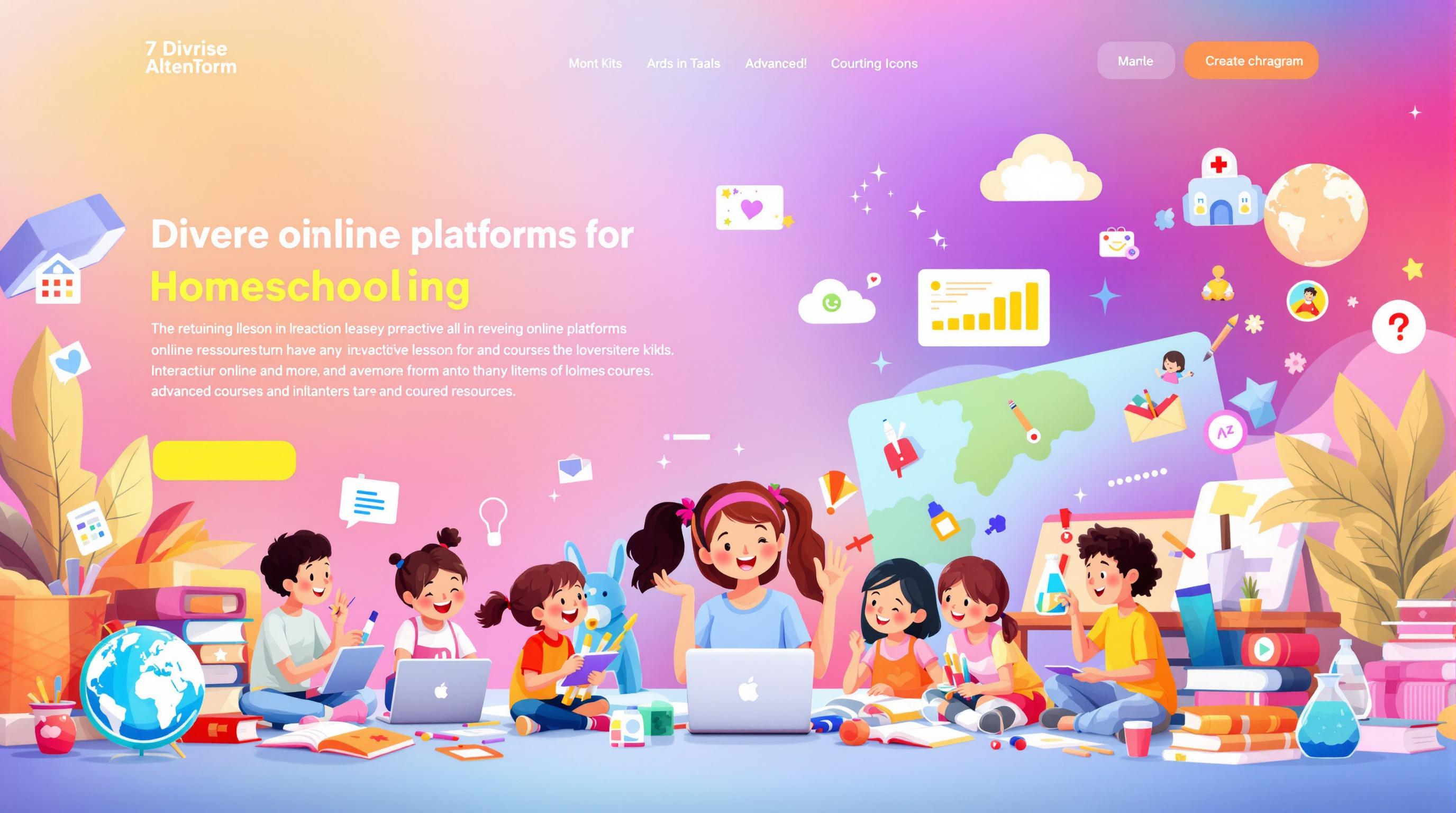Having tech issues with your homeschool video calls? You're not alone. Here's how to fix common problems and improve your online learning experience:
- Check your internet connection
- Fix audio problems
- Improve video quality
- Update your software
- Close unused programs
- Use a wired internet connection
- Have a backup plan
- Master your video call software
Quick comparison of key solutions:
| Problem | Quick Fix | Long-Term Solution |
|---|---|---|
| Slow internet | Close unused tabs/apps | Upgrade plan or switch providers |
| Poor audio | Use headphones | Invest in a better microphone |
| Bad video | Face natural light | Set up proper lighting |
| Software issues | Restart app | Keep everything updated |
| Connection drops | Use phone as hotspot | Switch to wired connection |
Remember: Test your setup before important calls to avoid last-minute panic. With these tips, you'll be a video call pro in no time.
Related video from YouTube
1. Check Your Internet Connection
A good internet connection is crucial for video calls. Here's how to make sure yours is up to the task:
Test Your Speed
Before your call:
- Visit SpeedTest.com or Fast.com
- Run a speed test
- Check your download and upload speeds
You need at least 5 Mbps for both to get good video quality. Zoom wants 1.8 Mbps for HD video in one-on-one calls.
If you're below that, try these quick fixes:
- Close unused tabs and programs
- Pause downloads or uploads
- Turn off other devices on your network
Boost Your Connection
If your connection is weak or unstable:
-
Get closer to your router: Sit nearby during calls.
-
Use a wired connection: An Ethernet cable beats Wi-Fi for speed and stability.
-
Optimize your Wi-Fi:
- Put your router in a central, high spot
- Keep it away from other electronics
- Use the 5 GHz band if you can
-
Manage network usage: Ask others to avoid streaming or gaming during your calls.
Still having issues? You might need to upgrade your plan or switch providers.
"I learned the hard way that a stable internet connection starts with a good provider. Constant dropped calls were driving me crazy. Upgrading my plan made all the difference."
2. Fix Audio Problems
Audio issues can ruin a homeschool video call. Here's how to fix common problems:
Adjust Mic and Speaker Settings
- Check your device selection in the video call app
- Stop echo by asking others to use headphones, mute when not talking, and move mics away from speakers
- Do a quick audio check before important lessons
Choose Better Audio Equipment
Upgrading your gear can help:
| Device | Price | Benefits |
|---|---|---|
| Apple EarPods | €19 | Good mic, cheap |
| Røde Podmic | €99 | High-quality sound |
| Blue Yeti | $129 | Popular for streaming |
Pro tip: Want clear audio on a budget? Try wired earbuds with a built-in mic.
"Headphones often fix echo in one-on-one calls." - Zoom support expert
For good audio:
- Put your mic 2-3 inches from your mouth
- Turn off noisy devices nearby
- Use Krisp for noise reduction (non-Mac users)
3. Improve Video Quality
Want better homeschool video calls? Focus on your camera and lighting.
Camera Settings
- Clean your webcam lens with a damp microfiber cloth.
- Check your camera's connection. Test it on another device if needed.
- Set video quality to 1280x720 or 1920x1080 for HD without huge files.
- Position your camera at eye level or slightly higher. Angle it down for better eye contact.
Lighting Setup
Good lighting doesn't need expensive gear:
- Use natural light when you can. Face a window for best results.
- No natural light? Put a lamp behind your computer.
- Avoid backlighting. Keep bright lights and windows out of frame.
Want a pro setup? Try this:
| Light Type | Position | Purpose |
|---|---|---|
| Key Light | Above and behind camera | Main light |
| Fill Light | Opposite key light | Soften shadows |
| Back Light | Behind you | Add depth |
On a budget? Smart LED bulbs in your existing lamps can work wonders.
4. Update Your Software
Outdated software can wreck your homeschool video calls. Here's how to keep things running smoothly:
Video Call Software
Take Zoom, for example. Updating is easy:
- Open Zoom
- Click your profile icon
- Hit "Check for Updates"
- Wait for the download
- Install
Can't update? Just grab the latest version from zoom.us/download.
"Zoom is requiring that you update the Zoom client on your computer to the latest version (or near it) to be allowed to proceed." - Russell H., Technician's Assistant
Pro tip: Turn on auto-updates in Zoom settings. Pick "SLOW" for fewer updates and more stability.
Computer Drivers
Old drivers = audio and video nightmares. On Windows:
- Press Windows + I
- Hit "Update & Security"
- Click "Windows Update" > "Check for Updates"
- If you see "View optional updates", click it
- Pick the latest driver update and install
Or do it manually:
- Press Windows + X
- Open Device Manager
- Find your device
- Right-click and pick "Update driver"
Note: Windows tests all drivers, so updates might be slow.
Keep everything up-to-date, and your homeschool video calls will thank you.
sbb-itb-fb77983
5. Close Unused Programs
Running too many programs can tank your video call quality. Here's how to fix it:
Find and Close Background Apps
- Open your task manager (Ctrl + Shift + Esc on Windows, Command + Space and type "Activity Monitor" on Mac)
- Look for apps hogging CPU or memory (browsers, editing software, file-syncing services)
- Close what you don't need (End Task on Windows, X button on Mac)
- Disable startup programs in Task Manager (Windows) or System Preferences > Users & Groups > Login Items (Mac)
Pro tip: Use "Do Not Disturb" during calls. It's in the top-right corner on Mac, and "Focus Assist" in the bottom-right on Windows.
Closing unused programs frees up resources for smoother calls. It's crucial for long homeschool sessions or live videos.
"Video calls drain energy fast. As your battery dies, your device changes settings to save power, which can hurt video quality."
For longer calls:
- Keep your device plugged in
- Close apps right after using them
- Restart your computer regularly
Don't forget to ask your family to avoid Netflix or online games during your calls. Your internet will thank you.
6. Use a Wired Internet Connection
Wi-Fi is great, but for video calls, a wired connection is often better. Here's why:
Why Go Wired?
Ethernet cables offer:
- Faster speeds
- Stable connection
- Less interference
- Better security
A Cat 6 cable can handle 1 Gbps over 328 feet. That's more than enough for smooth video calls.
How to Connect
It's easy:
- Plug one end into your router
- Plug the other end into your computer
- Your device should auto-detect the connection
That's it. You're wired up.
No Ethernet Port? No Problem
Here are some workarounds:
| Device | Solution |
|---|---|
| Laptop without Ethernet | USB to Ethernet adapter |
| Tablet or phone | Lightning or USB-C to Ethernet |
| Game console (e.g., Nintendo Switch) | LAN adapter |
These adapters are cheap and easy to find.
Pro tip for Nintendo Switch users: Connect a LAN adapter to the dock, plug in an Ethernet cable, then go to System Settings > Internet > Internet Settings. Choose "Wired Connection" and you're set.
If Wi-Fi keeps giving you trouble, try going wired. It could make a big difference in your homeschool video calls.
7. Have a Backup Plan
Tech issues happen. Be ready for them. Here's how to keep your virtual classroom running when things go wrong:
Other Ways to Connect
Have these backups ready:
- Phone as a hotspot
- Charged tablet or laptop
- Mobile data plan
"If Zoom fails, I try to reconnect for 15 minutes. If that doesn't work, I schedule a makeup or record the material." - Joel Shapiro, Northwestern University
If You Disconnect
Have a plan:
1. Set up a backup communication channel
2. Agree on a waiting time (like 15 minutes)
3. Have pre-recorded content ready
| Backup | Good | Bad |
|---|---|---|
| Mobile Hotspot | Quick setup | Limited data |
| Pre-recorded Content | Always available | Less interactive |
| Alternate Device | Different connection | Might lack features |
8. Master Your Video Call Software
Knowing your video call software can make or break your homeschooling experience. Here's how to use key features and fix common hiccups.
Screen Sharing and Other Tools
Screen sharing is a game-changer. Here's how to use it:
- Share videos with sound: In Zoom, click screen-share, select desktop, choose "optimize for full-screen video clip", then share.
- Use a document camera: Connect a second device to show hands-on work.
- Try co-annotation: Let students draw on shared screens.
Other useful tools:
- Breakout rooms for group work
- Chat for quick questions
- Polls for quick checks
Troubleshooting Common Issues
Quick fixes for common problems:
| Problem | Solution |
|---|---|
| Audio issues | Check mic settings, use "original sound" |
| Video freezing | Close unused apps, check internet speed |
| Can't share screen | Update Zoom, check share settings |
Keep your software updated. Zoom made about 1,000 updates in one year!
"I've learned a lot watching your Zoom webinars. My students have noticed and I share with you their kudos." - Dr. Ron Owston, blended learning researcher
Conclusion
Video conferencing is crucial for homeschooling, but tech hiccups can throw a wrench in the works. Here's how to keep your online learning on track:
- Check your internet
- Fix audio issues
- Boost video quality
- Update software
- Close unused programs
- Use wired internet
- Have a backup plan
- Master your video call software
Here's a shocker: 95% of virtual conferences start late because of tech problems. Yikes! The culprits? Usually poor internet or outdated software.
Want to avoid that mess? Do this:
- Keep your software fresh
- Use noise-canceling headsets
- Find a quiet, well-lit spot
- Run test calls
Bottom line: Test your setup BEFORE important calls. Your future self will thank you.


